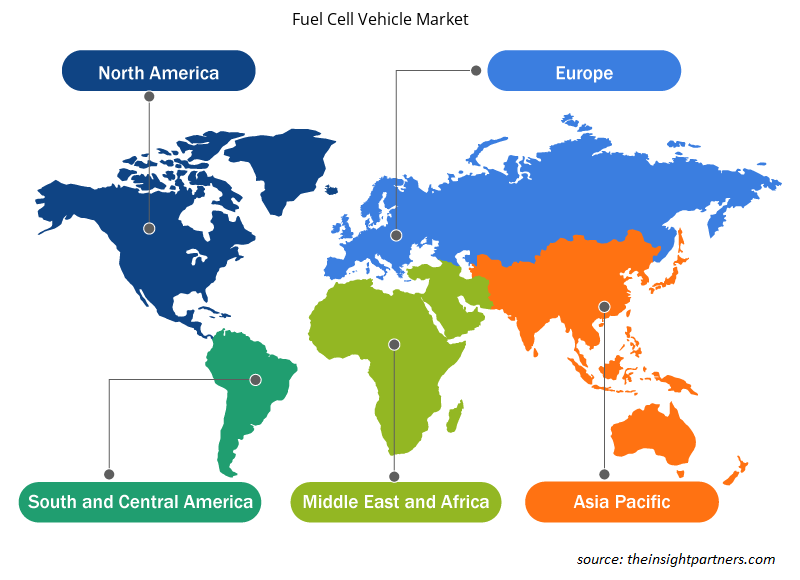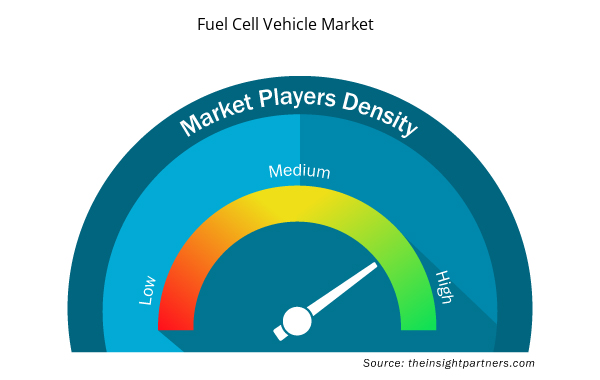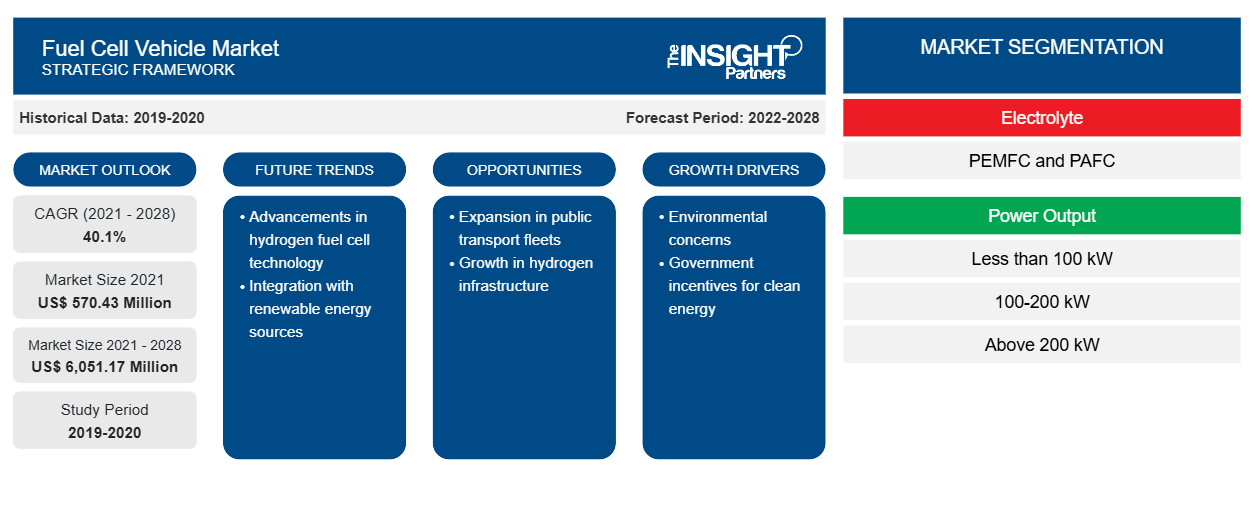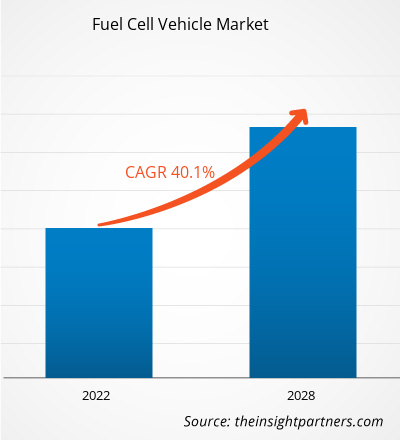[研究报告] 燃料电池汽车市场规模预计将从 2021 年的 5.7043 亿美元增至 2028 年的 60.5117 亿美元;预计 2021-2028 年期间的复合年增长率为 40.1%。
分析师观点:
近年来,燃料电池汽车市场作为传统汽油动力汽车的有前途的替代品,获得了极大的关注和发展。燃料电池汽车 (FCV) 由氢燃料电池驱动,通过氢和氧之间的化学反应产生电能,产生的排放物是水蒸气。FCV 的主要优势之一是环保。由于它们只排放水蒸气,因此有助于减少温室气体排放和空气污染,解决气候变化和城市污染的全球问题。这一特点促使政府加大对采用和开发燃料电池技术的支持和激励。就市场增长而言,燃料电池汽车市场稳步发展。
汽车制造商和技术公司一直在大力投资研发,以提高燃料电池汽车的效率、性能和价格。因此,燃料电池汽车的续航里程显著增加,解决了最初与续航里程有限有关的担忧之一。尽管与传统内燃机和电动汽车相比,燃料电池汽车市场规模仍然相对较小,但预计未来几年将出现大幅增长。对可持续交通解决方案的需求增加,加上燃料电池技术和基础设施发展的进步,可能会推动市场扩张。此外,汽车制造商、能源公司和政府之间的伙伴关系和协作正在促进燃料电池汽车市场的增长。这些联盟旨在加速燃料电池汽车的部署并促进研发。
市场概况:
燃料电池汽车市场专注于采用燃料电池技术的汽车,该技术利用氢作为燃料源来发电。由于日益增长的环境问题和对可持续交通选择的需求,该市场出现了显著增长。政府法规和激励措施在推动燃料电池汽车的采用方面发挥了至关重要的作用。燃料电池技术的进步、行业利益相关者之间的合作以及持续的研发努力进一步推动了市场的扩张。高成本和基础设施有限等挑战仍然存在,但随着技术的进步和对更清洁的交通解决方案的需求不断增加,市场未来增长潜力巨大。
定制此报告以满足您的需求
您可以免费定制任何报告,包括本报告的部分内容、国家级分析、Excel 数据包,以及为初创企业和大学提供优惠和折扣
- 获取此报告的关键市场趋势。这个免费样品将包括数据分析,从市场趋势到估计和预测。
市场驱动因素:
环保意识增强推动燃料电池汽车市场增长
日益增长的环境问题已成为燃料电池汽车市场增长的重要驱动力。随着人们越来越意识到传统汽油动力汽车对环境的有害影响,对更清洁、更环保的交通替代品的需求也日益增长。这种增强的环保意识为燃料电池汽车创造了有利的市场环境。燃料电池汽车利用氢气作为燃料源,氢气是一种丰富而清洁的能源载体。当氢气与氧气在燃料电池中混合时,会产生电能,而水蒸气是唯一的副产品。这种无排放操作是吸引环保消费者的关键因素。人们对空气污染和温室气体排放的认识不断提高,导致政府和监管机构实施了更严格的环境法规。许多国家和地区都制定了雄心勃勃的目标,以减少碳排放并鼓励可持续交通。作为回应,汽车制造商越来越专注于开发燃料电池汽车作为其产品组合的一部分,以满足这些法规并吸引有环保意识的客户群。
此外,燃料电池技术的进步也显著提高了燃料电池汽车的性能和效率。这些汽车现在的行驶里程更长、加油时间更短,更适合日常使用。 加氢站基础设施的不断增长也支持了燃料电池汽车市场的增长,解决了燃料电池汽车应用面临的主要挑战之一。此外,汽车制造商、能源公司和政府对燃料电池技术的投资和研究力度不断加大,加速了燃料电池汽车的开发和商业化。这些投资不仅提高了燃料电池的技术能力,还有助于降低燃料电池的生产成本,使其在市场上更具竞争力。
节段分析:
根据车型,燃料电池汽车市场细分为乘用车、公共汽车、卡车和轻型商用车。乘用车细分市场在 2020 年占据了最大的市场份额,预计在预测期内将实现最高的复合年增长率。由于各种因素,乘用车细分市场已成为燃料电池汽车市场的最大份额。全球越来越关注减少碳排放和向可持续交通转型,这增加了对燃料电池汽车的需求。汽车制造商已投资开发和商业化燃料电池乘用车,以提高其效率、续航里程和可负担性。
燃料电池乘用车车型种类繁多、氢基础设施不断进步,以及燃料电池技术的优势(如续航里程长、加油时间短)都为该细分市场的成功做出了贡献。总体而言,乘用车细分市场反映了燃料电池技术在汽车行业日益普及和可行性的提高。
区域分析:
2021 年亚太地区燃料电池汽车市场价值为 3.0169 亿美元,预计到 2028 年将达到 41.139 亿美元;预计在预测期内复合年增长率为 45.2%。亚太地区已成为燃料电池汽车市场的主导力量。由于人口众多、城市化进程迅速以及对污染和气候变化的日益担忧,该地区积极采用更清洁、更可持续的交通方式。该地区占据主导地位的关键因素之一是政府的大力支持和促进燃料电池汽车应用的政策。日本、韩国和中国等国家实施了优惠的法规、税收优惠和补贴,以鼓励使用燃料电池汽车。这些措施为制造商、投资者和消费者创造了有利的环境,促进了市场增长。尤其是日本,一直处于燃料电池汽车开发和部署的前沿。日本政府为氢能基础设施发展设定了雄心勃勃的目标,旨在全国范围内建立加氢站网络。
此外,丰田和本田等日本主要汽车制造商已在燃料电池汽车研发方面投入大量资金,并将丰田 Mirai 和本田 Clarity 等车型推向了商业化。韩国在燃料电池汽车市场也取得了显著进展。政府优先发展氢基础设施,并积极支持燃料电池公交车和商用车的部署。现代和起亚等总部位于韩国的公司通过现代 Nexo 和起亚 Niro 等创新车型,在推动燃料电池汽车的普及方面发挥了重要作用。由于人口众多且对空气污染的担忧日益增加,中国也认识到了燃料电池汽车的潜力。中国政府为燃料电池汽车生产提供了慷慨的补贴和目标,以使中国成为氢技术的全球领导者。包括比亚迪、北汽和吉利在内的多家中国汽车制造商已在燃料电池汽车开发方面投入巨资,为该地区的整体市场主导地位做出了贡献。此外,亚太地区也受益于其强大的制造能力和技术专长。成熟的汽车制造商和强大的供应链促进了燃料电池汽车的生产和商业化。此外,该地区拥有先进的研发中心、学术机构以及产学研合作,推动了燃料电池技术的发展。
关键球员分析:
燃料电池汽车市场分析包括现代汽车公司、丰田汽车公司、康明斯公司、通用汽车、沃尔沃集团、本田汽车有限公司、Riversimple、Hyzon Motors、戴姆勒股份公司和巴拉德动力系统公司等参与者。在燃料电池汽车参与者中,康明斯公司和现代汽车公司因其提供多样化的产品组合而成为最重要的参与者。
燃料电池汽车市场区域洞察
Insight Partners 的分析师已详尽解释了预测期内影响燃料电池汽车市场的区域趋势和因素。本节还讨论了北美、欧洲、亚太地区、中东和非洲以及南美和中美洲的燃料电池汽车市场细分和地理位置。

- 获取燃料电池汽车市场的区域具体数据
燃料电池汽车市场报告范围
| 报告属性 | 细节 |
|---|---|
| 2021 年市场规模 | 5.7043亿美元 |
| 2028 年市场规模 | 60.5117 亿美元 |
| 全球复合年增长率(2021 - 2028) | 40.1% |
| 史料 | 2019-2020 |
| 预测期 | 2022-2028 |
| 涵盖的领域 | 按电解质
|
| 覆盖地区和国家 | 北美
|
| 市场领导者和主要公司简介 |
|
燃料电池汽车市场参与者密度:了解其对业务动态的影响
燃料电池汽车市场正在快速增长,这得益于终端用户需求的不断增长,而这些需求又源于消费者偏好的不断变化、技术进步以及对产品优势的认识不断提高等因素。随着需求的增加,企业正在扩大其产品范围,进行创新以满足消费者的需求,并利用新兴趋势,从而进一步推动市场增长。
市场参与者密度是指在特定市场或行业内运营的企业或公司的分布情况。它表明在给定市场空间中,相对于其规模或总市场价值,有多少竞争对手(市场参与者)存在。
在燃料电池汽车市场运营的主要公司有:
- 现代汽车公司
- 丰田汽车公司
- 康明斯公司
- 通用汽车
- 沃尔沃集团
免责声明:上面列出的公司没有按照任何特定顺序排列。

- 了解燃料电池汽车市场主要参与者概况
最新动态:
燃料电池汽车市场中的公司大量采用并购等无机和有机战略。以下列出了一些近期的关键市场发展:
- 2021 年 4 月,SAFRA Materiel Transport Public 与 Symbio(米其林和佛吉亚的子公司)签署了生产 1500 辆氢动力公交车的协议。
- 2020 年 12 月,丰田推出了新款汽车 Mirai。该车采用以氢为燃料的燃料电池。丰田 Mirai 的油箱容量为 142.2 升,燃料电池的最大功率为 171 马力,峰值扭矩为 221 牛米。
- 历史分析(2 年)、基准年、预测(7 年)及复合年增长率
- PEST 和 SWOT 分析
- 市场规模价值/数量 - 全球、区域、国家
- 行业和竞争格局
- Excel 数据集



Report Coverage
Revenue forecast, Company Analysis, Industry landscape, Growth factors, and Trends

Segment Covered
This text is related
to segments covered.

Regional Scope
North America, Europe, Asia Pacific, Middle East & Africa, South & Central America

Country Scope
This text is related
to country scope.
常见问题
Hyundai Motor Company, Toyota Motor Corporation, Ballard Power Systems Inc, Hyzon Motors, and Daimler AG are among the leading players offering innovative solution in the market .
Increasing Demand for Clean Energy
Declining Cost of Green Hydrogen
The forecast period for the global fuel cell vehicles market is 2021 to 2028.
The fuel cell vehicle market is expected to witness steady growth during the forecast period from 2021 to 2028, owing to the rising demand from passenger car segment.
APAC is likely to register for the highest CAGR in the fuel cell vehicles market during the forecast period.
The region includes major nations such as India, China, Japan, South Korea, and Australia. South Korea and China are the fastest-growing manufacturing markets in APAC.
Adoption of heavy duty trucks has increased considerably in the recent years. For instance, China witnessed a rise in the registrations of electric vehicles in 2020 by 10% in comparison to 2019. Further, the new registrations for heavy duty vehicles increased by 23% in Europe. Companies operating in the global truck market are working progressively towards the adoption of fuel cell trucks due to longer range the trucks offer. Companies operating in the fuel cell vehicles market have taken up numerous initiatives to boost the adoption of fuel cell trucks in the global market. For Instance, in January 2022, H2 Mobility announced that it aims at deploying 2,000 fuel cell powered trucks on the European roads by 2030.
Based on electrolyte type, the fuel cell vehicles market is segmented into PEMFC and PAFC. The PEMFC segment led the fuel cell vehicles market with a share of more than 99% in 2020
Trends and growth analysis reports related to Automotive and Transportation : READ MORE..
The List of Companies - Fuel Cell Vehicles Market
- Hyundai Motor Company
- Toyota Motor Corporation
- Cummins Inc
- General Motors
- AB Volvo
- Honda Motors Co., Ltd.
- Riversimple
- Hyzon Motors
- Daimler AG
- Ballard Power Systems Inc
The Insight Partners performs research in 4 major stages: Data Collection & Secondary Research, Primary Research, Data Analysis and Data Triangulation & Final Review.
- Data Collection and Secondary Research:
As a market research and consulting firm operating from a decade, we have published and advised several client across the globe. First step for any study will start with an assessment of currently available data and insights from existing reports. Further, historical and current market information is collected from Investor Presentations, Annual Reports, SEC Filings, etc., and other information related to company’s performance and market positioning are gathered from Paid Databases (Factiva, Hoovers, and Reuters) and various other publications available in public domain.
Several associations trade associates, technical forums, institutes, societies and organization are accessed to gain technical as well as market related insights through their publications such as research papers, blogs and press releases related to the studies are referred to get cues about the market. Further, white papers, journals, magazines, and other news articles published in last 3 years are scrutinized and analyzed to understand the current market trends.
- Primary Research:
The primarily interview analysis comprise of data obtained from industry participants interview and answers to survey questions gathered by in-house primary team.
For primary research, interviews are conducted with industry experts/CEOs/Marketing Managers/VPs/Subject Matter Experts from both demand and supply side to get a 360-degree view of the market. The primary team conducts several interviews based on the complexity of the markets to understand the various market trends and dynamics which makes research more credible and precise.
A typical research interview fulfils the following functions:
- Provides first-hand information on the market size, market trends, growth trends, competitive landscape, and outlook
- Validates and strengthens in-house secondary research findings
- Develops the analysis team’s expertise and market understanding
Primary research involves email interactions and telephone interviews for each market, category, segment, and sub-segment across geographies. The participants who typically take part in such a process include, but are not limited to:
- Industry participants: VPs, business development managers, market intelligence managers and national sales managers
- Outside experts: Valuation experts, research analysts and key opinion leaders specializing in the electronics and semiconductor industry.
Below is the breakup of our primary respondents by company, designation, and region:

Once we receive the confirmation from primary research sources or primary respondents, we finalize the base year market estimation and forecast the data as per the macroeconomic and microeconomic factors assessed during data collection.
- Data Analysis:
Once data is validated through both secondary as well as primary respondents, we finalize the market estimations by hypothesis formulation and factor analysis at regional and country level.
- Macro-Economic Factor Analysis:
We analyse macroeconomic indicators such the gross domestic product (GDP), increase in the demand for goods and services across industries, technological advancement, regional economic growth, governmental policies, the influence of COVID-19, PEST analysis, and other aspects. This analysis aids in setting benchmarks for various nations/regions and approximating market splits. Additionally, the general trend of the aforementioned components aid in determining the market's development possibilities.
- Country Level Data:
Various factors that are especially aligned to the country are taken into account to determine the market size for a certain area and country, including the presence of vendors, such as headquarters and offices, the country's GDP, demand patterns, and industry growth. To comprehend the market dynamics for the nation, a number of growth variables, inhibitors, application areas, and current market trends are researched. The aforementioned elements aid in determining the country's overall market's growth potential.
- Company Profile:
The “Table of Contents” is formulated by listing and analyzing more than 25 - 30 companies operating in the market ecosystem across geographies. However, we profile only 10 companies as a standard practice in our syndicate reports. These 10 companies comprise leading, emerging, and regional players. Nonetheless, our analysis is not restricted to the 10 listed companies, we also analyze other companies present in the market to develop a holistic view and understand the prevailing trends. The “Company Profiles” section in the report covers key facts, business description, products & services, financial information, SWOT analysis, and key developments. The financial information presented is extracted from the annual reports and official documents of the publicly listed companies. Upon collecting the information for the sections of respective companies, we verify them via various primary sources and then compile the data in respective company profiles. The company level information helps us in deriving the base number as well as in forecasting the market size.
- Developing Base Number:
Aggregation of sales statistics (2020-2022) and macro-economic factor, and other secondary and primary research insights are utilized to arrive at base number and related market shares for 2022. The data gaps are identified in this step and relevant market data is analyzed, collected from paid primary interviews or databases. On finalizing the base year market size, forecasts are developed on the basis of macro-economic, industry and market growth factors and company level analysis.
- Data Triangulation and Final Review:
The market findings and base year market size calculations are validated from supply as well as demand side. Demand side validations are based on macro-economic factor analysis and benchmarks for respective regions and countries. In case of supply side validations, revenues of major companies are estimated (in case not available) based on industry benchmark, approximate number of employees, product portfolio, and primary interviews revenues are gathered. Further revenue from target product/service segment is assessed to avoid overshooting of market statistics. In case of heavy deviations between supply and demand side values, all thes steps are repeated to achieve synchronization.
We follow an iterative model, wherein we share our research findings with Subject Matter Experts (SME’s) and Key Opinion Leaders (KOLs) until consensus view of the market is not formulated – this model negates any drastic deviation in the opinions of experts. Only validated and universally acceptable research findings are quoted in our reports.
We have important check points that we use to validate our research findings – which we call – data triangulation, where we validate the information, we generate from secondary sources with primary interviews and then we re-validate with our internal data bases and Subject matter experts. This comprehensive model enables us to deliver high quality, reliable data in shortest possible time.


 获取此报告的免费样本
获取此报告的免费样本